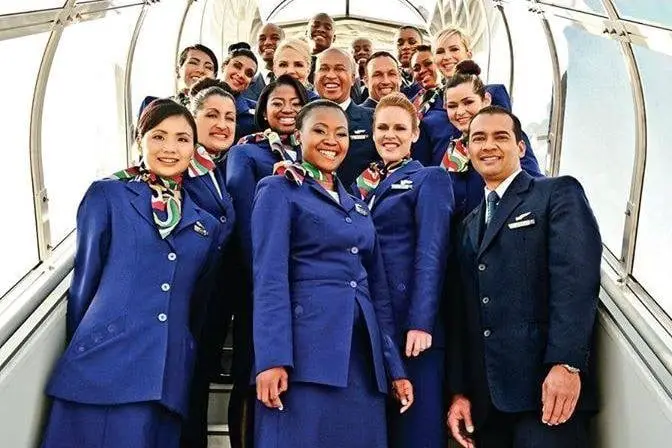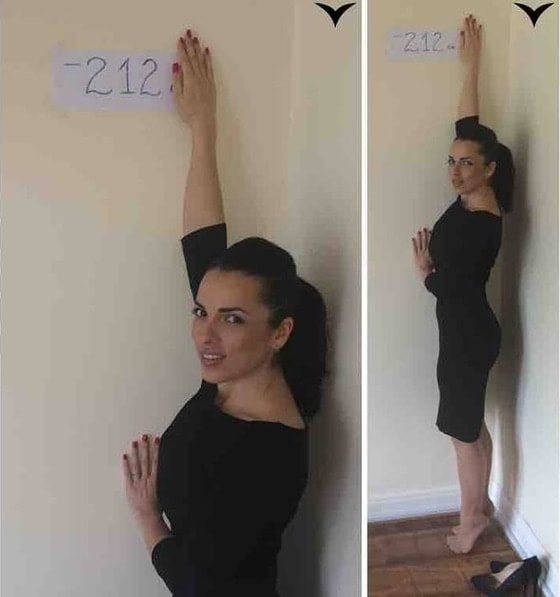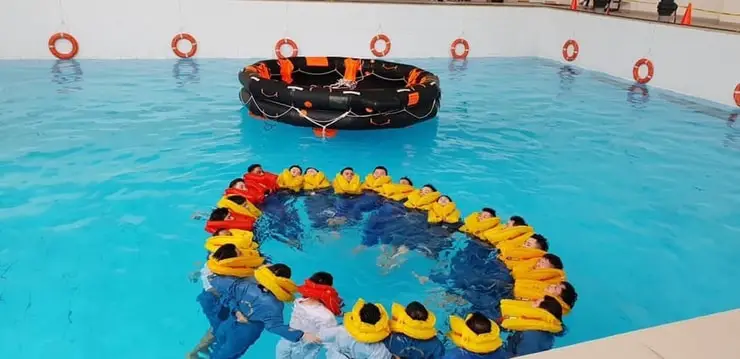
In this article, I’m going to cover the very basic requirements needed to become a flight attendant.
I’ve put all this together based on my experience as an international flight attendant and from discussions from my many friends and colleagues in the airline industry.
I’ve included the official and the not-so-official requirements of airlines and I’ve given you some very handy and practical tips on what to expect and what to do when you are pursuing a flight attendant career.
Table of Contents
1) Nationality – can I work anywhere in the world?

‘Can a Non-US citizen work as a flight attendant for US airlines?’ and, ‘Is it possible to get a flight attendant job for a European airline if I am an American citizen?’
The answer to both those questions is, yes.
Nationality is not usually a job defining issue for airlines, but you will need to be a legal resident in the country that you are based in and you must also have a working visa.
Be aware that most airlines will NOT provide visa sponsorships for flight attendants and that they won’t consider your application unless you can prove that you have a working permit for the country in which you will be based.
As far as I know, only a few private jet companies, the Middle East airlines such as Emirates, Qatar, or Etihad and some Asian airlines like – Cathay Pacific, Hainan Airlines, China Southern will arrange a work visa for you.
These airlines are known for hiring a mix of people from different countries up to a certain quota. So if you want to work for one of these, then go for it.
2) Age – Is there an upper and lower limit?
All airlines have a minimum age requirement. For most, it’s eighteen years old. But it can be twenty or twenty-one for some US companies.
The maximum age limit to become a flight attendant is never usually mentioned in application documents or referred to in interviews, as it would be work discrimination based on age.
Ageism, in a word.
So let’s talk about this uncomfortable subject for a bit.
Although it’s seldom mentioned, even in this day and age we see cases of age discrimination in the airline industry.
Some companies exclusively hire only young flight attendants, especially in Middle East and Asian airlines, it’s very unlikely that you will find employment as a flight attendant after you are thirty to thirty-five years old. This especially applies if you have no previous experience in the job.
From the point of view of these companies, an employee in their twenties can focus more on their career since they will have no family responsibilities. They will be more flexible, complain less and better represent the company’s public image.
And because of this branding, companies like Emirates, Qatar, Etihad Gulf Air, usually hire people between 21 and 32 years old.
Even though there’s not always a maximum age requirement written into their job specifications, they still have a marked preference for younger candidates.
The same thing happens in Asian companies like China Eastern, Singapore Airlines, Thai Airways, Air China, Eva Air, or China Eastern – the maximum age is around 27 to 28.
But having said that, you can still try for a position. I have two friends who joined Emirates at the ages of 33 and 35. So it is possible. Not easy, but possible.
Lordy, Lordy, I feel so old as I am writing this. No, not old; mature and experienced and having a huge amount to offer!
But take heart, US airlines and some EU airlines are very accepting of anyone who is above their minimum age requirement.
In Europe, the maximum age limit (even though unspoken) is more flexible, but it does depend on each airline.
In British Airways, Easyjet, Finnair, there is no age limit at all and they will even hire people over 50 years old.
Also, all the American and Australian companies hire candidates of any age above the minimum.
That’s a big ‘Bravo!’ from me to all those companies.
It’s bewildering to know that such things are still happening in this day and age, but I guess it’s just the mentality of the individual country and the airline company’s culture.
I’ll give you an example of what Qatar Airways Chief Executive, Akbar Al Bake, once said at a business conference.
Feel free to get angry:
“By the way, the average age of my cabin crew is only 26 years, so there is no need for you to travel on these crap American carriers. You know you are always being served by grandmothers at American carriers.”
Thankfully and rightly, after this he had to apologize and write a letter doing so to the AFA (Association of Flight Attendants), a union group of more than 50,000 flight attendants from over 20 American airlines.
TIP: It’s not a bad idea to go to their website https://www.afacwa.org/and do some research about your future career.
More on this topic: Am I Too Old to Be a Flight Attendant?
3) Minimum height – how short is too short?

So exactly what is the height requirement to be a cabin crew member?
This is established by each company and you’ll normally find the information on their application websites.
Generally, it varies in general between 5 feet 2 inches (158cm) and 6 feet 1 inch (185cm).
The reason for the minimum height requirement is that a flight attendant must be able to reach the safety equipment placed in the overhead compartments in order to carry out emergency procedures.
But while the requirement is mainly for safety reasons, it is also to help passengers who are boarding to find space, or to make space, for their luggage.
The maximum height is not a problem, there are not many airlines putting a maximum height requirement, so being tall is usually an advantage, although being too tall in the confines of an aircraft may be less than comfortable on a long trip.
But there are some airlines that don’t want their cabin crew to be too tall because their planes are smaller and they have less headroom. In these cases, staff need to be less than 6 feet 1 inch or 185cm.
Let’s look at some examples for the height requirement in different airlines:
European Airlines:
- British Airways: from 5’2 to 6’1 (157cm to 185cm)
- Aer Lingus: from 5’2 to 6’2 (158 cm to 182 cm)
- Iberia: minimum 164 cm women; 175cm men
- Lufthansa: 158 cm
- Swiss Air: 158 cm
Middle East Airlines:
- Emirates: minimum height of 160cm+arm reach of 212cm
- Air Arabia: 160cm
- Oman airlines: 157 cm
Asian Airlines:
- Singapore Airlines: 158cm females; 165cm males
- Air Asia: 157cm females; 173cm males
- Philippines airlines: 5’3″ females; 5’6″ males
US Airlines:
- Mesa Airlines: 4’11”-6′
- PSA: Minimum 5’2″
You’ll find more examples in my article How Tall Do I Need to Be to Become a Flight Attendant?
To check that the height you mentioned in your resume corresponds to your actual height, on the day of the interview many airlines will measure you without your shoes on.
But there are some airlines that don’t measure your height. Instead, they’ll make you do a little test to make sure that you’ll be able to reach the overhead compartments on the plane.
This is called the arm-reach test, which I think is a much fairer way to go.
In the arm-reach test, the required height will be marked on a wall with a sticker and candidates will be called and asked to remove their shoes and then they’ll have to raise their arm/s to see if they can reach the mark.
Examples of airlines arm reach requirements are:
- Etihad: able to reach 212 cm without shoes.
- JetBlue: able to reach 6’3” without shoes.
- Frontier Airlines: ability to reach into overhead compartments with a height of 67” and depth of 28
- Cathay Pacific: able to reach 208 cm without shoes.
Is it possible to be a flight attendant if you are short?
If your height is below the requirement, don’t panic, you do have a few options:
- You can still try the airline that you wish to work for if you are only one or two centimeters below the requirement. Any shorter than that and it really doesn’t make much sense in you applying.
- You may be rejected by an airline, but why not try a different one? You might get lucky if they don’t have enough applicants and they waive their height requirement.
- The other option is to apply to airlines that don’t have a height requirement or the ones that are asking only for the arm-reach test instead of a minimum height.
4) Education, languages – what do I need?

In most airlines, you need to have completed secondary education or have finished High School.
To be honest, it does help if you have achieved a higher level of education than that.
But, look, if you don’t have a College or University education, don’t worry, it’s not mandatory.
It’s only some Asian airlines or private aviation companies that ask for a university degree.
In terms of languages, English is a basic requirement for any airline in the world.
You’ll need to have a high level both in speaking and writing it. This is a must.
English is the international language of the aviation world, from the cockpit to the control tower.
And, depending on the airline, you may also need a second language.
In Europe, for example, they usually require you to speak the language of the home country where the airline is based as well as English.
For example:
- Air France will ask their cabin crew to speak French and English.
- KLM, the national Dutch carrier: Dutch, and English
- Iberia, the Spanish flag carrier: Spanish and English.
Of course, if you speak a third language this will be highly valued, but it’s not necessary.
Can I apply for a cabin crew job if I can’t speak English?
Yes and no.
You don’t need to speak English like a native, but you will have to use English almost every day at work and study many things that are written in English as part of your training.
If you are not a native English speaker, your English will be tested on the day of the interview.
So your chances for success are enhanced if you are as fluent as you can possibly be in the language.
So polish up your skills before you apply. Go to some language exchange meetups, take some conversation classes, and travel abroad to English-speaking countries.
English is not as hard a language to speak as some people make out, so a little practice really does go a long way.
You can find more about this in my article: English for Cabin Crew: how to improve it and pass your interview.
5) Swimming skills – is it really necessary?

During the cabin crew licensing training course, you will have to pass a test to prove that you can swim.
In many countries in Europe, for example, you must be able to swim 50 meters in less than 2 minutes and 30 seconds to pass.
In other countries, it’s enough to be able to swim 50 meters unaided across a pool that’s about 2 meters deep, with no timing.
The test is usually not done wearing a swimming suit, it’s done in full clothing to simulate a plane-ditching situation.
Each airline will have different exercises, so if you ask me what the swimming tests are like in training, I can only guide you from my personal experience.
- First, you swim 50 meters – which is an Olympic pool size – with your clothes on.
- Next, you have put your lifejacket on, jump in the water, inflate your lifejacket, and swim back to the end you started from.
- You will have to drag someone from one end of the pool to the other with both of you wearing a lifejacket.
- You must demonstrate that you can tread water for 1 to 2 minutes without wearing a lifejacket.
- Jump into the water, swim to the middle of the pool, climb onto a life raft and help others to get on board.
- Complete 8 meters of continuous underwater swimming
You’ll probably spend the whole morning doing this, but that’s basically all there is to it.
Which probably sounds like more than enough to you.
You can find more about this topic in my article: Do You Need to Be Able to Swim to Be a Flight Attendant?
Look, I’m not a confident swimmer, can I still be cabin crew?
If you don’t know how to swim, or if you are not very confident in the water, it’s okay, you don’t have to be an amazing lifeguard, just be able to complete the tests.
However, I would recommend that you take swimming classes before the training starts or go to the pool, and until you are totally confident in the water.
In these videos, you can see some examples of the training that is done.
BAA Training: ditching and water survival
KLM training in water
And don’t get too nervous – your classmates will be in the same position and people who are confident will help you, everyone is in it together and will be supportive.
Don’t worry.
6) Health requirements – how strict are these?
Once you have passed the cabin crew training course, you will have to successfully pass an aeronautical medical examination.
In Europe, for example, we need to pass the EASA class 2 aeromedical examination in order to be allowed to fly.
These tests are carried out by an aeromedical doctor and all new cabin crews are required to take this initial medical exam in order to get their license.
Then after every 5 years up to the age of forty, or every 2 years if you are between forty and fifty years old.
If you develop a medical condition, or if you come back from a long illness, then you may need to take this test again.
But if you are a normally fit and healthy person, the medical is a pretty easy one to pass.
So exactly what does an EASA class 2 medical exam consist of?
- Your medical history: the doctor will ask you questions about previous illnesses.
- Weight and height: weight should be proportionate to height.
- Urine test: to detect drugs or diabetes. Remember that it is totally prohibited to consume drugs, and if during your career as a flight attendant drugs are detected in your test you will lose your job immediately. No ifs, no buts, no excuses.
- Blood test: checking for abnormalities such as anemia, cholesterol, or epilepsy.
- Blood pressure: to detect hypertension.
- Electrocardiogram: to test your heart rate and detect arrhythmias or heart disorders.
- Hearing and sight test: if you wear glasses or lenses don’t forget to take them. You will be OK with astigmatism not exceeding 2 dioptres and hypermetropia or myopia not exceeding 5 dioptres. Also, color vision testing is usually carried out using the Ishihara test.
- Spirometry (in the initial test only): to detect abnormalities in the lung or respiratory function such as asthma.
How much does the aeromedical test cost?
Most airlines will pay for this once you are hired.
But if you need to pay for it yourself, the cost can vary a lot.
It depends on the medical center, the country, even the province and whether or not it’s an initial examination or the extension of a previous one.
Generally, the range is somewhere from €150 an extension to €280 for an initial.
Other requirements to keep in mind
There are other requirements that I didn’t mention here, but just briefly, here are some of them:
- Criminal record check certificate: if you’re in the United Kingdom or US you will also be required to provide a 5 or 10 year checkable background. You’ll have to give details about your employment and education history in the last 5-10 years without leaving any gaps.
- Flexible in geographical relocation: as a flight attendant you need to be ready to be based in any city. The company will decide where that will be, so re-location is a large aspect of becoming a flight attendant that you definitely need to be aware of.
- Customer service experience really does count. Fortunately, if you don’t have any, it’s a skill that is very easy to acquire. No need to get a job specifically for this thing outside of the box. What about volunteer work? Charity shops, tour guiding for a local historic site, anything that gets you interacting with customers will be invaluable.
- No visible tattoos, piercings, extreme hair colors, or hairstyles.
Conclusion
I know what you’re thinking, this all seems to be more difficult than trying to get into NASA.
But it’s not, you just need to be a little bit lucky and research all about the recruitment process in the airline you want to work for and, most important of all, prepare yourself.
I’m not going to lie.
It’s a long process.
It will probably take you a couple of months, and the training will be hard and intense, but you’ll meet a lot of lovely people and in the end, it will all have been worth it.
I wish you the best of luck!
And if you have any questions, I’ll be in the section comments down below!




I’m 4’11 I live in South Carolina would they accept me if I’m 4’11
Hi Britney! Fortunately, in the US, many airlines have shifted away from strict height criteria for flight attendants. So it depends on the airline. I recommend checking out this article I wrote on how tall do I need to be a flight attendant.It goes into depth on the topic and should provide you with some valuable insights. Best of luck on your journey!
Hi Coral so you really think I have a chance of getting my dream being real of becoming a flight attendant even though English is my second language and most airlines that I have read the requirements said that writing is a requirement and that’s where I have difficulty of spelling words😞. The good thing is that I can read and speak two languages Spanish is my first.